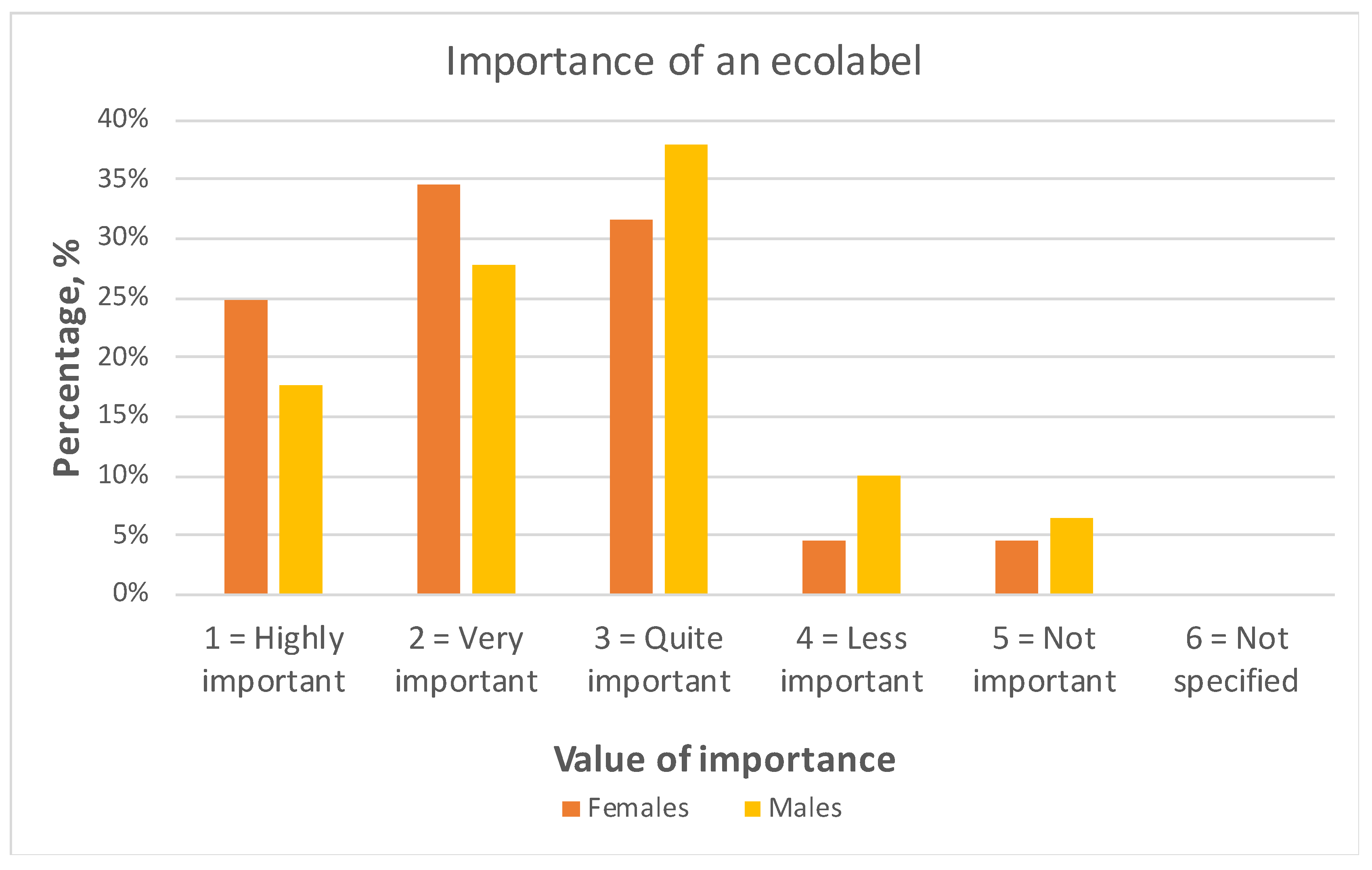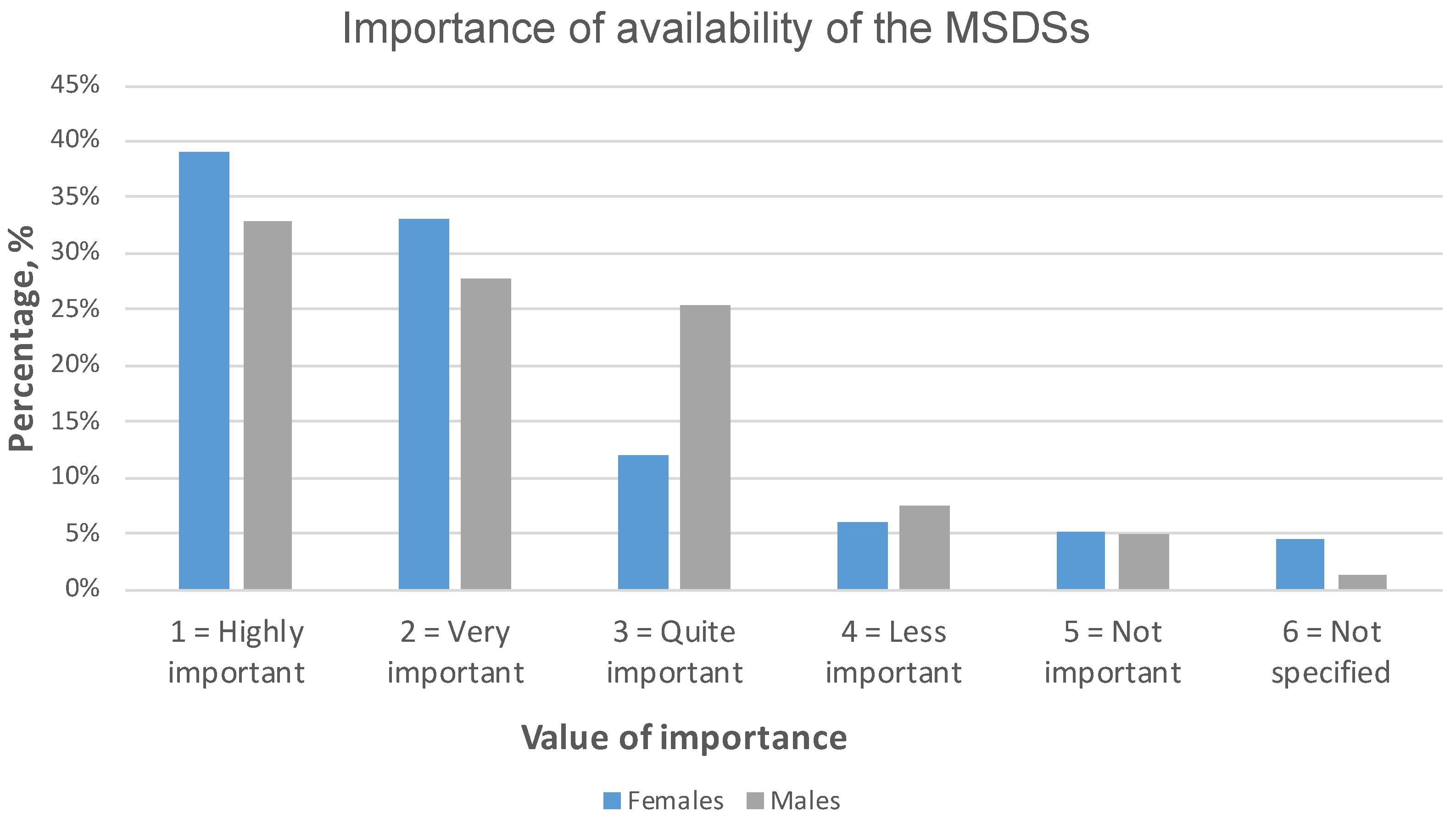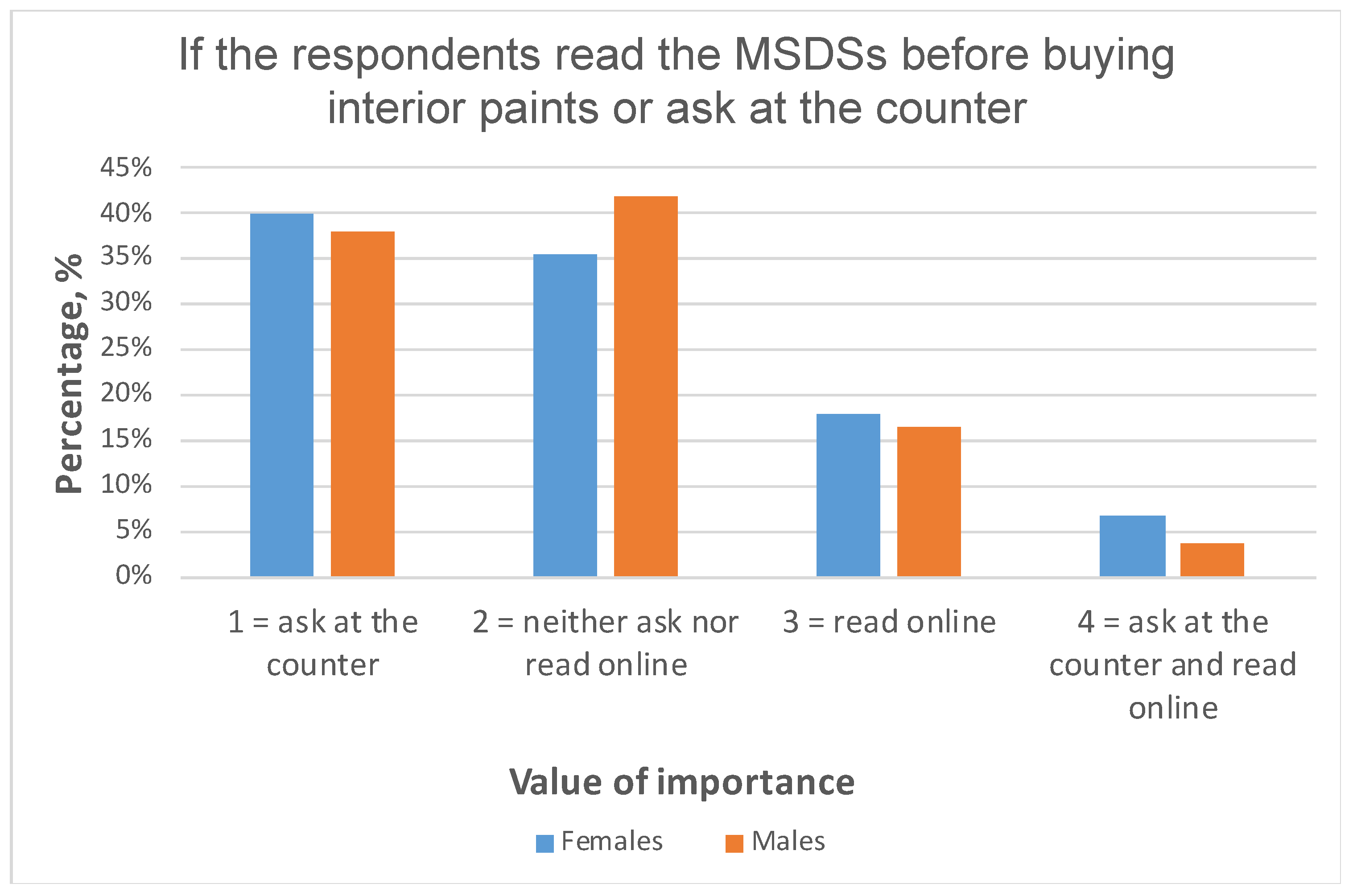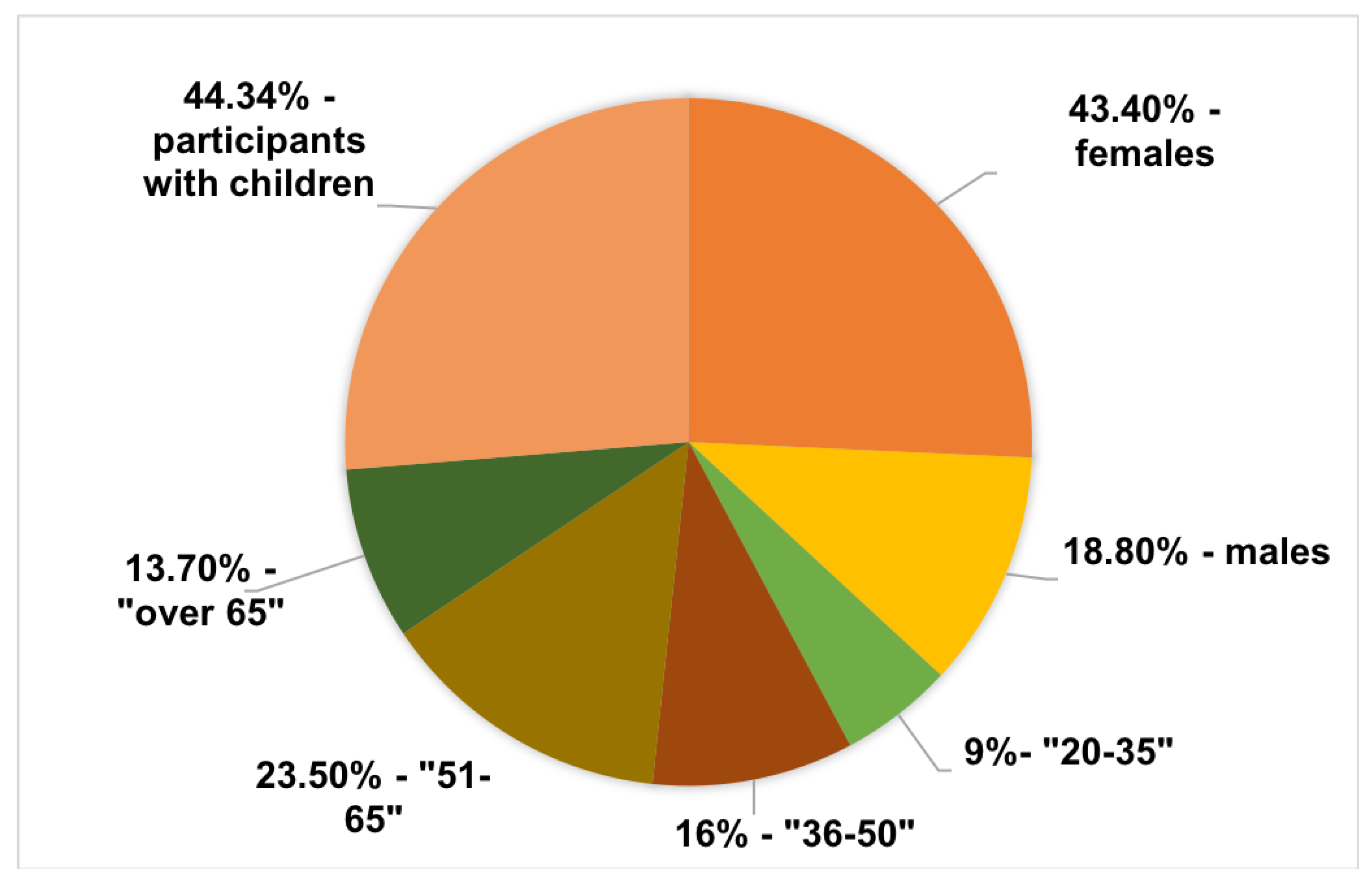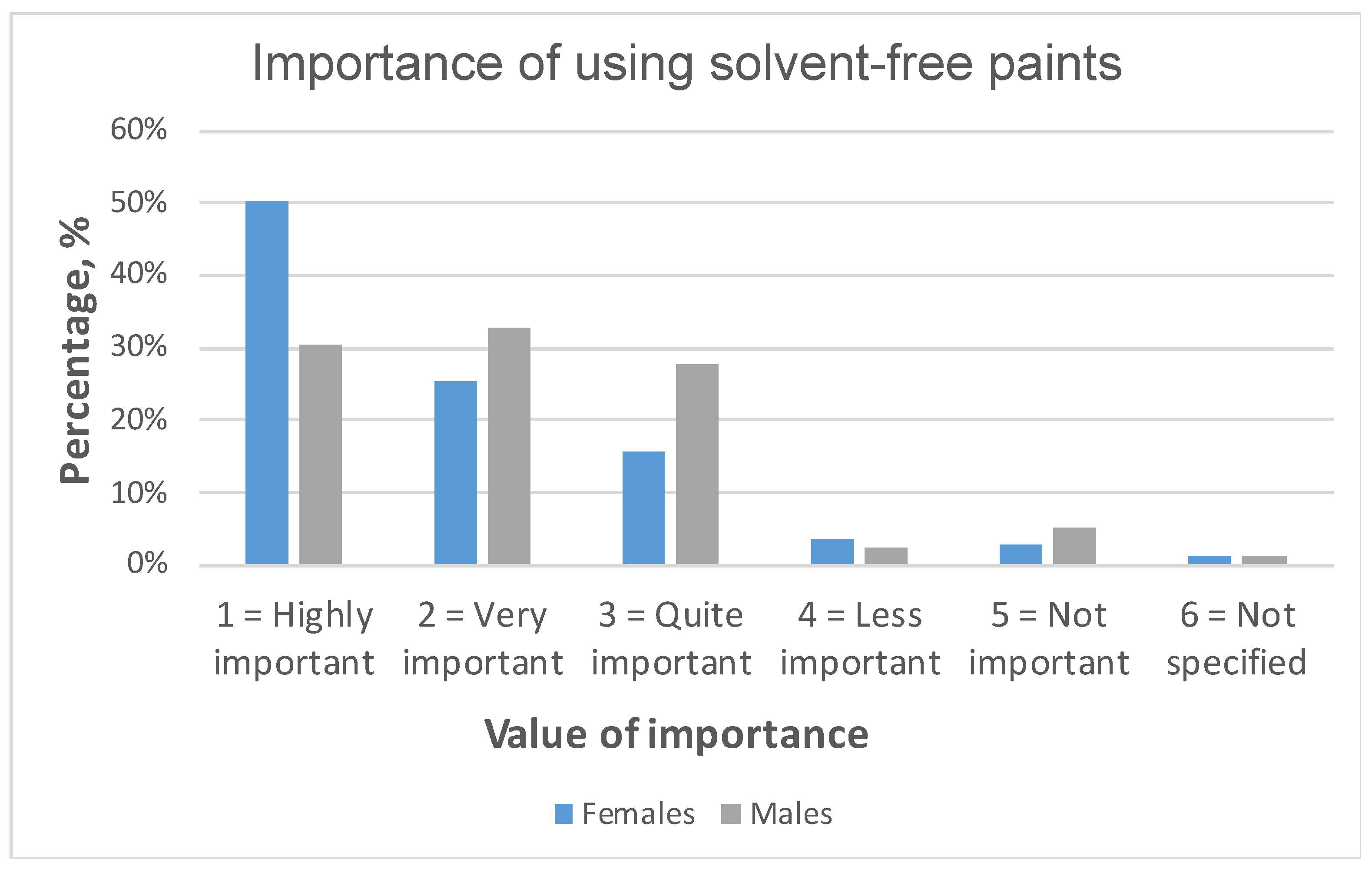1. Introduction
This paper aims to investigate the importance of ecolabels for decorative paints and the importance of using solvent-free paints for the average consumer. Decorative paint products may evaporate hazardous emissions such as volatile organic compounds (VOCs) and formaldehydes. However, decorative paints and varnishes with the ecolabels contain no to low concentrations of hazardous chemical components. Nevertheless, studying the paints’ packaging revealed that a great amount of decorative paints available in the German market do contain low concentrations of formaldehyde and VOCs. However, even in low air concentrations, VOCs can cause an irritation of the eyes and respiratory organs [
1]. Thus, decorative paints containing VOCs may cause allergies for odour sensitive people. As researched by Mendell [
2], leukaemia, lymphoma and nasal cancer may be relative risks caused by indoor VOCs. Moreover, according to Derwent et al. [
3], the VOC emissions play a crucial role in the photochemical ozone formation of the atmosphere. According to Venkatram, use of paints and organic solvents in North America caused about 31% of anthropogenic emissions of the VOCs in 1985 [
4]. According to a 2014 National Emissions Inventory of the US Environmental Protection Agency, in 1990–2014, the overall anthropogenic VOC emissions in the US followed a decreasing trend from ca. 23 to ca. 13 million tons [
5]. Despite significantly decreasing VOC emissions from such areas as fuel combustion and on-road vehicles, industrial processes caused the major share of VOC emissions. In 2014, anthropogenic VOC emissions in the US resulted in about 25% of the total amount [
5]. In 2018 and 2019, only in Los Angeles, there were about 35% to 40% of anthropogenic emissions of the product- and process-related VOCs, including paints and organic solvents [
6]. However, this is an exceptional case for the US counties.
Properties of the coating material can be classified according to DIN EN 13300 [
7]. Furthermore, the product must not contain any plasticizer classified as harmful to the environment, as defined in the Classification, Labelling and Packaging (CLP) Regulation 1272/2008 [
8,
9]. In addition, a content of the VOCs shall not exceed 0.2% of a product, and a proportion of preservatives in total may not exceed 0.1% [
10]. The European Directive 2004/42/EC set the maximum allowed limit of the VOCs for water-borne and solvent-borne coatings for decorative walls at 30 g/L [
11].
For decorative paints, the Technical Bulletin contains detailed information including all ingredients. In addition, the Material Safety Data Sheet (MSDS) of a paint includes information on potentially hazardous substances and its properties, such as toxicity, biodegradability and flammability. In the European Union, paint manufacturers are obligated to hand out the MSDSs to professional users but not to average consumers [
2,
12]. To average consumers, MSDSs can be handed out upon request. Being at risk, average consumers have to ask for the MSDSs by themselves prior to purchasing a paint, or they have to find the MSDSs online.
The environmentally conscious behaviour of the average consumer in Germany was studied thoroughly in the past years. Starting from 1996, the German Federal Environmental Agency conducts a representative survey (
n > 2000) on environmental consciousness every two years. In recent years, environmental consciousness was rising among German citizens. In 2018, the German Federal Environmental Agency reported that 64% of the respondents named environmental and climate protection as a basic requirement for managing important future tasks such as globalisation. In comparison with the survey results from the previous years, 40% of the respondents stated the importance of environmental and climate protection in 2012, 63% in 2014 and 53% in 2016 [
13,
14,
15,
16,
17].
In accordance with a “Factsheet for Paints and Varnishes” published by the Commission of the European Parliament for do-it-yourself users, the EU Ecolabel for indoor and outdoor paints and varnishes is the official European label for greener products [
18]. The EU Ecolabel may be awarded to indoor as well as outdoor decorative paints and varnishes, wood stains and related products intended for consumer and professional use that fall under the scope of Directive 2004/42/CE of the European Parliament and of the Council [
11]. The EU Ecolabel placed on a paint package shows that a paint contains a reduced content of volatile organic compounds (VOCs). Such paint guarantees a good performance. This applies for indoor as well as for outdoor use of paints.
In 2010, according to the Ecolabel Background Report, 1188 products had the EU Ecolabel product group licenses [
19]. Among those, indoor and outdoor paints and varnishes comprised 8.1%. Overall, in Germany, there were four companies with EU Ecolabel products. However, the EU Ecolabel website currently presents two holders of licences for do-it-yourself indoor and outdoor paints and varnishes in Germany, and both lie within DAW SE, the largest manufacturer in the paint and coatings industry in Germany and the fourth largest company of its kind in Europe (2020).
In 2012, as the Ecolabel Background Report states, Germany was the largest market with respect to paint sales containing a great amount of environmentally friendly paints labelled with the Blue Angel ecolabel, which was created in 1978 [
18,
20]. Additionally, approximately two thirds of paints and coatings produced in Germany fell into the categories of low solvent or solvent-free. Furthermore, within the do-it-yourself trade, there was a widespread use of water-based paints as well. Overall, in 2012, more than one thousand individual products in the paint and printing ink industry in Germany were awarded the Blue Angel ecolabel. The Blue Angel ecolabel applies to interior paints that contain less of certain critical materials, including VOCs. The paint products meet strict limits on VOCs reducing indoor and outdoor air pollution without 25 prohibited toxic chemicals, e.g., benzene, formaldehyde and heavy metals [
20]. Overall, around 48 German organisations held the Blue Angel ecolabel in 2012.
In 2020, according to the Blue Angel ecolabel website, 43 German paint manufacturers held this ecolabel. Among those, 506 indoor paint products were awarded with the Blue Angel ecolabel. Furthermore, 58 German manufacturers producing varnishes, glazes and primers held this ecolabel as well. Among those, 898 products were awarded with the Blue Angel ecolabel [
18].
Gaus and Zanger made a survey targeting the importance of ecolabelling by using the example of the perception of the Blue Angel ecolabel [
21]. The study presented the decreasing relevance of ecolabels for decisions to buy ecolabelled products. In 2003, Grunenberg and Kuckatz stated that people under 25 were not familiar with the Blue Angel ecolabel [
22]. Further studies with respect to the perception and importance of ecolabels for average consumers were conducted by the Federal Ministry for the Environment, Nature Conservation and Nuclear Safety in Germany. These studies also showed a reduction in the percentage of respondents who paid attention to the Blue Angel ecolabel: from 42% in 2006 to less than 40% in the period of 2006–2008 [
13].
The German Federal Environmental Agency published results of another representative survey in terms of the environmental consciousness of the average consumer [
14]. The survey revealed differences regarding the name recognition and relevance of the Blue Angel ecolabel in individual population groups. The Blue Angel ecolabel was known mainly in the age groups of 30 to 65 year olds and showed significantly weaker importance among younger age groups. Furthermore, less than 30% of respondents under 30 mentioned that they paid attention to the ecolabel on the packaging when they purchased products. Independent of the equal awareness of the Blue Angel ecolabel, 42% of females and 35% of males said that they looked for the Blue Angel ecolabel on the product packaging.
Stiess and Birzle-Harder conducted a study in relation to the recognition and perception of ecolabels, including the Blue Angel ecolabel, Bio logo, EU Ecolabel, EU Energy label and Fairtrade label, using an online poll [
23]. Online results revealed 93% name recognition of the Blue Angel ecolabel. At the same time, 26% of the respondents were conscious, 42% knew only a bit, 14% knew less and 7% knew nothing about this ecolabel. In 2012, 46% of the respondents bought products with the Blue Angel ecolabel on the packaging. Additionally, an assessment of a product portfolio in the “Paints and Varnishes” category revealed that 68% of the respondents supposed there were products with the Blue Angel label, while 12% supposed the opposite. Therefore, for this product group, the Blue Angel ecolabel was attractive and plausible because of its purpose of environmental and health protection [
23].
In order to study the environmental consciousness of the average consumer in Germany and attitudes towards use of the decorative paints, this paper sets the six following hypotheses:
Hypothesis 1 (H1). Females and males score the importance of ecolabels differently. Females give smaller scores than males.
Hypothesis 2 (H2). Respondents with children pay more attention to ecolabels.
Hypothesis 3 (H3). Females and males score the importance of the availability of the MSDSs differently. Females give smaller scores than males.
Hypothesis 4 (H4). Respondents with children pay more attention to the MSDSs.
Hypothesis 5 (H5). Females and males score the importance of using solvent-free paints differently. Females give smaller scores than males.
Hypothesis 6 (H6). Respondents with children pay more attention to the use of solvent-free paints.
This paper presents an evaluation of the study with the questionnaire survey that was conducted at trade fairs for construction products in Germany. As described in
Section 1, the introduction, this study was focused on the paints’ properties and the importance of ecolabels for decorative paints and using solvent-free paints as assessed by German consumers on a Likert-scale from one to five.
Section 2 of this paper describes the research questionnaire survey used in the study and presents the statistical methods used for the evaluation. Based on the statistical analysis, the results of the respondents’ assessments are presented using
t-tests and discussed in
Section 3 of this paper. Finally,
Section 4 introduces the main conclusions within the survey and discusses possible limitations of the study.
3. Results
The results of the questionnaire survey showed that the majority of the respondents, namely, 88%, stated the importance of an ecolabel for any construction product they used.
Responding to the question concerning the importance of an ecolabel for a construction product (M = 2.41; SD = 1.06), the analysis indicated that it had the highest value of importance among respondents with 22%. Among them, 25% of females and 18% of males stated that it had the highest value of importance. Moreover, while 32% of the respondents answered “very important”, almost 34% of respondents selected “quite important”.
Figure 1 shows the percentage distribution of the responses on a Likert-scale among females and males.
When asked about the importance of the Material Safety Data Sheets handed out with paint products (M = 2.22; SD = 1.33), 37% of respondents selected “highly important”. Among them, 39% were females and 33% were males.
Overall, 31% of the respondents selected “very important”, while only 16% of them responded “quite important”.
Figure 2 shows the distribution of responses on a Likert-scale among females and males.
However, when asked if the respondents read the MSDSs prior to the paint purchase or asked for the MSDSs at the counter of the construction store, 39% responded that they asked at the counter (40% females and 38% males). Almost 38% responded that they neither asked at the counter nor read the MSDSs online prior to a paint purchase (35% females and 42% males). And 17.5% responded that they read the MSDSs online.
Figure 3 shows the distribution of responses among females and males.
In order to investigate the relevance of the ecolabels, the question on the importance of the Blue Angel ecolabel was included in the survey. More precisely, the respondents were asked if they pay attention to the Blue Angel ecolabel on the packaging of the decorative paints. No Likert-scale was suggested for this question. Instead, the respondents were supposed to answer “yes” or “no”. This information appeared in [
25].
Figure 4 demonstrates the responses distribution.
However, most of the participants who responded “no” to this question stated that they “have never thought about this ecolabel” or that they “heard about it (the Blue Angel ecolabel) for the first time”.
The importance value of using the solvent-free decorative paints, which means paints that do not contain any VOC or formaldehyde, was high among the participants in the survey. Almost half of the respondents, i.e., 43%, noted that it is “highly important” for them to use a decorative paint that is solvent-free (M = 2.01; SD = 1.16). Moreover, whilst 28% of the respondents noted it as “very important”, 20% noted it as “quite important” for them.
Figure 5 demonstrates the distribution of the responses on a Likert-scale among the female and the male participants.
Statistical Analysis with t-Tests
The six hypotheses set in this study were analysed using
t-tests with the help of the MS Office Excel with Data Analysis Toolkit. A statistical
t-test is a type of inferential statistics for determining the existence of a significant difference between the average means of two groups. A statistical
t-test is usually used as a hypothesis testing tool. This allows testing of an assumption applicable to a whole population. In this study, the
t-tests were determined as two-sample tests assuming unequal variances. In order to specify a direction, the hypotheses were tested with directional one tail [
24]. This means the statistical tests were addressed to show if there was any difference in the importance values among different groups of respondents. According to Field,
p-value should be less than α, and α = 0.05 for a one-tailed test [
24]. M means the average mean, and SD means the standard deviation [
24,
26]. Note that the Likert-scale used for the survey was one to five, where one suggested the highest importance value and five suggested no importance value.
Hypothesis 1 (H1). Females and males score importance of ecolabels differently. Females give smaller scores than males, a one-tailed test.
Female participants (M = 2.29, SD = 1.04, n = 133) were hypothesised to give smaller scores to the importance of eco-certificates than males (M = 2.59, SD = 1.09, n = 79). This difference was significant, t (210) = 1.65, p = 0.02, which is less than α, α = 0.05, one tail. Thus, the hypothesis H1 was supported. Females gave higher importance value to the ecolabels for decorative paints than males.
Hypothesis 2 (H2). Respondents with children pay more attention to ecolabels, a one-tailed test.
Statistical test showed that respondents with children (M = 2.32, SD = 1.03, n = 137) pay more attention to ecolabels than respondents without children (M = 2.56, SD = 1.12, n = 75).
However, the difference is not significant, t (210) = 0.06, p = 0.06, which is greater than α, α = 0.05, within a one-tailed test. Hence, the hypothesis H2 was not supported. Behaviour of the respondents with children towards ecolabels was not different from behaviour of the respondents without children.
Hypothesis 3 (H3). Females and males score importance of the availability of the MSDSs differently. Females give smaller scores than males, a one-tailed test.
Female participants (M = 2.19, SD = 1.93, n = 133) were hypothesised to give smaller scores to the importance of the availability of the MSDSs than males (M = 2.28, SD = 1.49, n = 79). Moreover, the difference appeared significant, t (210) = 1.65, p = 0.02, which is less than α, α = 0.05, one tail. Thus, the hypothesis H3 was supported. Females gave higher importance value to the availability of the MSDSs for decorative paints than males.
Hypothesis 4 (H4). Respondents with children pay more attention to MSDSs, a one-tailed test.
The statistical test showed that respondents with children (M = 2.05, SD = 1.43, n = 137) pay more attention to the MSDSs than respondents without children (M = 2.53, SD = 2.23, n = 75). Moreover, this difference is significant, t (210) = 1.65, p = 0.01, which is less than α, α = 0.05, within a one-tailed test. Hence, the hypothesis H4 was supported. The respondents with children pay more attention to the MSDSs than respondents without children.
Hypothesis 5 (H5). Females and males score importance of using solvent-free paints differently. Females give smaller scores than males, a one-tailed test.
Female participants (M = 1.88, SD = 1.32, n = 133) were hypothesised to give smaller scores to the importance of using solvent-free paints than males (M = 2.23, SD = 1.31, n = 79). Moreover, the difference appeared significant, t (210) = 1.65, p = 0.02, which is less than α, α = 0.05, one tail. Thus, the hypothesis H5 was supported. Females gave higher importance value to using solvent-free decorative paints than males.
Hypothesis 6 (H6). Respondents with children pay more attention to use solvent-free paints, a one-tailed test.
The statistical test showed that respondents with children (M = 1.80, SD = 0.97, n = 137) pay more attention to use of solvent-free paints than respondents without children (M = 2.39, SD = 1.81, n = 75). Moreover, this difference is significant, t (210) = 1.65, p = 0.00, which is less than α, α = 0.05, within a one-tailed test. Hence, the hypothesis H6 was supported. The respondents with children pay more attention to use of solvent-free decorative paints than respondents without children.
4. Conclusions
This paper presented the results of the questionnaire survey that was conducted at trade fairs for construction products in Germany. Overall, 212 visitors of the trade fairs agreed to participate in the survey. The main objective of the survey was to study the environmental consciousness of the average consumer and the importance of ecolabels for decorative paints.
In comparison to the studies of environmentally conscious behaviour of the average consumer in Germany from 2010, the overall percentage of respondents that pay attention to the Blue Angel ecolabel is rising, namely, it is 62.2%. However, most of the people who answered negatively to the question about the Blue Angel ecolabel were not aware of the existence of this ecolabel. Moreover, females and males were not aware of the Blue Angel ecolabel in equal proportions. Thus, females paid explicitly more attention to it while purchasing products, 43.4 to 18.8%, respectively.
The age of the respondents also played a role in decision-making about products with the Blue Angel ecolabel. Hence, 70% of respondents in the age group of 36–65 years old were aware of the Blue Angel ecolabel and paid more attention to it. However, as for younger people, only 32.2% of the respondents under 30 paid attention to the Blue Angel ecolabel on the packaging. This confirms the findings of the German Federal Environmental Agency [
11]. However, most of the people in the age group over 65, that is 90%, knew the Blue Angel ecolabel and paid attention to it in their decision-making about products. However, in this study, 212 people participated in the survey for the average consumer. Sample size may influence the hypotheses significance testing results. Moreover, sample size of the female group (
n = 133) was greater than of the male group (
n = 79). However,
t-tests were made assuming unequal variances.
This paper described statistical testing confirmation within
t-tests for six directional hypotheses among females and males and participants with and without children.
Table 2 gives an overview of the results within the statistical hypothesis testing confirmation using
t-tests. Overall, five hypotheses were supported.
Females gave higher importance values to the ecolabel, the availability of the MSDSs for decorative paints and the use of solvent-free paints than males. Having children appeared to influence the respondents to pay more attention to the MSDSs for decorative paints. Moreover, having children appeared to also influence the respondents to pay more attention to the use of solvent-free decorative paints. Interestingly, respondents with children do not pay more attention to the ecolabels when they purchase a decorative paint. In other words, the behaviour of the respondents with children towards ecolabels was not different from the behaviour of the respondents without children. The results of this study can be of importance for paint manufacturers. Studies on the environmental consciousness of the average consumer are relevant for bringing the research on this issue forward. Furthermore, an update on this study may be a significant extension for future research.
